I get asked from time to time if it’s hard to maintain the healthy eating at such a high level. It’s not a piece of cake (pun intended), but I have a few habits I’ve developed that allow me to keep the flywheel going.
- Don’t keep unhealthy food at home. Apart from alcohol, I have an extremely low amount of unhealthy food/drink in my house. And what I do have is only there because I already had it, like if I bought some snacks because I was having friends over who wanted more than just carrot and celery sticks.
- Do keep plenty of healthy, ready-to-eat snacks on hand. So that when I do get that hankering for just a little something, I end up choosing something healthy because it’s available and convenient.
- Have some ready-made/easy-to-make backup dinner options. When I don’t feel like making dinner from scratch that night, it’s great to have something ready-made (my go-to is a veggie stew) or something that I don’t have to spend much time preparing. Or at least I can combine with something else so I still save time/effort.
- Eat at home as much as possible. Options for healthy food when eating out are limited, and it’s difficult to know/control all the details about the constituent parts of your meal.
- Get to know restaurants that do have healthy options. So if I do end up eating out, I have some healthy mainstays to choose from. My new favorite is Veggie Grill.
The way I’ve really gotten this to work is by spending a few hours prepping for the week on Sunday (or Monday night if I’m travelling or run out of time). And it doesn’t have to take a long time. Here’s what I did in 3 hours last night after work (including driving) to set myself up for success this week.
- Went grocery shopping at Costco on the way home from work. Got the ingredients I needed to make my weekly veggie stew, fruits and veggies for snacks, and other stuff I might like to use during the week. Because I do this regularly, I already had some of the ingredients I needed at home (like beans).
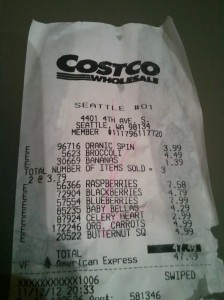
- Made a veggie stew/chili. (That’s an 11 quart pot.) I’ll post the recipe another time, but it’s basically a veggie chili recipe (based on the one from Eat to Live), and I just throw a bunch of other vegetables in there. This time it had carrots, celery, onion, garlic, garbanzo beans, black beans, kidney beans, tomatoes, broccoli, cauliflower, spinach, corn, mushrooms, and spices (chili powder, cumin, Mrs. Dash, and some cayenne pepper for a kick). Some of the ingredients are frozen (like chopped spinach or broccoli) and others are canned (like beans and tomatoes). Fresh is usually better of course, but veggies are so much more nutritious than the alternatives, I don’t get hung up on using frozen/canned vegetables. And in some cases, frozen can be more nutritious than fresh because of time spent in shipping, sitting on shelves, and so forth.

- Prepared some fruits and veggies as snacks. Every week, I cut and wash some fruits and veggies and pack them in plastic containers so that I always have healthy snacks ready to go. For fruits I usually do blueberries, strawberries, raspberries, and blackberries, but this week strawberries were not available.
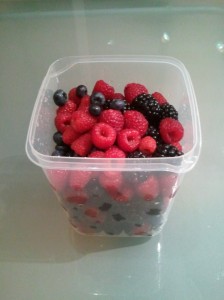 For vegetables I usually just do baby carrots and celery sticks, but this week I added some broccoli.
For vegetables I usually just do baby carrots and celery sticks, but this week I added some broccoli.
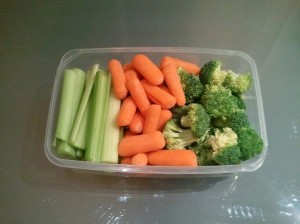 And I make a LOT of each.
And I make a LOT of each.
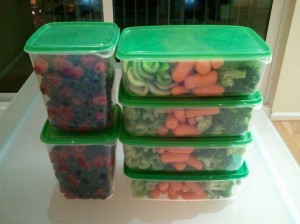
And after dishing out the soup into plastic containers, here’s how my fridge looked. Still some beer in there, just in case… 🙂
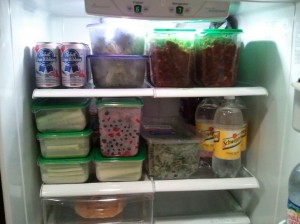
Great tips. I especially like the idea of taking the time to prepare healthy snacks. I’m really good about making meals but always end up reaching for crap when it comes to snack time. 🙂
It totally works too! At least it does for me… My latest healthy snack craze is nori, the roasted seaweed used for sushi. It’s crunchy and salty, and it has unbelievably amazing nutrition facts! And you can even buy it on Amazon: http://www.amazon.com/Sushi-Nori-Seaweed-Sheets-Roasted/dp/B007U29UYS/. The only downside is it can be a bit messy, but still worth it. 🙂